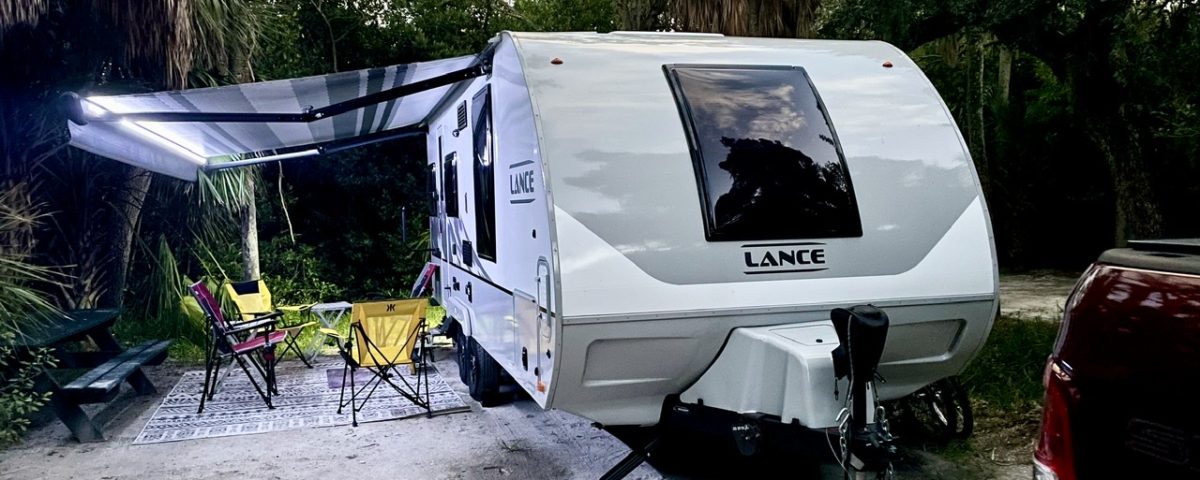Packing for Camping
Approximately once a month, we take a camping trip. To simplify our packing for camping, we try to keep as much equipment as we can packed in some manner so it is always ready to go. For example:
- Under the Bed-Extension cords, co-axiel cable, television antenna, awning, a few long tools that will not fit in our toolbox, charcoal, umbrella, 30/50 amp converter, nylon cord, and extra flashlight are kept under the bed in the camper and are always ready to go.
- Inside the Cabin-Hanging shoe bags are attached to the wall on each side of the bed. A laundry bag and manuals are in a cabinet. A flashlight for getting up in the middle of the night is in the space between the bed and wall. These items are always there and ready to go.
- In the Galley-The galley always has some basic items: dish cloths and towels, salt and pepper, basic spices, olive oil, a small coffee pot, toaster, small garbage can and trash liners, small flashlight, lighter, wet wipes, Saran Wrap, aluminum foil, bug spray, dish drainer mat, scrubber, tire gauge, wet wipes and hand sanitizer. We also keep our 30/15 converter on a shelf in the galley because we always hook our camper up to our home power before trips.
- In a Footlocker- All the dishes that we might use for cooking are stored in a large plastic footlocker. This includes plates, utensils, glasses, bowls, skillet, pan, etc. The only extra we sometimes bring is a crockpot or small grill, but that is only if there is a specific plan to use it.
Galley Storage



When leaving for a trip, we use the galley area to store items needed to hook up. We put the electrical cord and water hoses there, plus the hand tool for the camper stabilizers. We also strap gallon containers of water to the cabinet and store a foam rubber that rug we always use behind the galley. Those items are readily available when we arrive at our campsite.

Cabin Storage
We always transport the footlocker, rectangular table, small blower bucket, and small folding table in the cabin of the camper.

Tow Vehicle Storage
We use the back of our SUV to store food, chairs, a rug and whatever optional equipment we are taking. We have a 10×10 screen room, EZ tent, porta potty, and privacy tent. If the trip is more geared to sightseeing or we are at a site for less than 2-3 days, we do not set up a tent or screen room. If we are very near a restroom, we leave the porta potty at home.
With most camping items pre-packed, I spend most of my trip preparation on determining what food to bring and what clothes to pack. We store food that does not require refrigeration in three covered bins. One bin is always prepacked with dishwashing liquid, a small bottle of laundry detergent, tablecloths/clips, and coffee filters and the other two have specific food for the trip. There is also a bin for tools–my husband likes to be prepared.
We each pack a small suitcase and take a pre-packed bath bag with toiletries. We have found that it works better to use the backseat of our SUV for personal items. They are always in the same spot, therefore, it is easier to locate needed items. My husband’s items are on one side of the backseat and mine the other. We each use the floorboard for extra shoes, hats, etc. Also, we generally transport a small ice chest in the middle and a couple of lanterns in the floorboard.

Length of Trip
Our longest trip so far has been a week. We have discussed much longer trips and the plan for those is not very different from our packing for camping today. For those longer trips, we would just do laundry and buy groceries while traveling. I can’t wait to try out this theory! (This link is to a post for planning our first long trip)
Packing for camping takes effort, but for me, prepacking and organization makes it easier. I am sure that most seasoned campers have methods that work for them and may be quite different from what I have described, but this is what works for us.
HAPPY PACKING!


